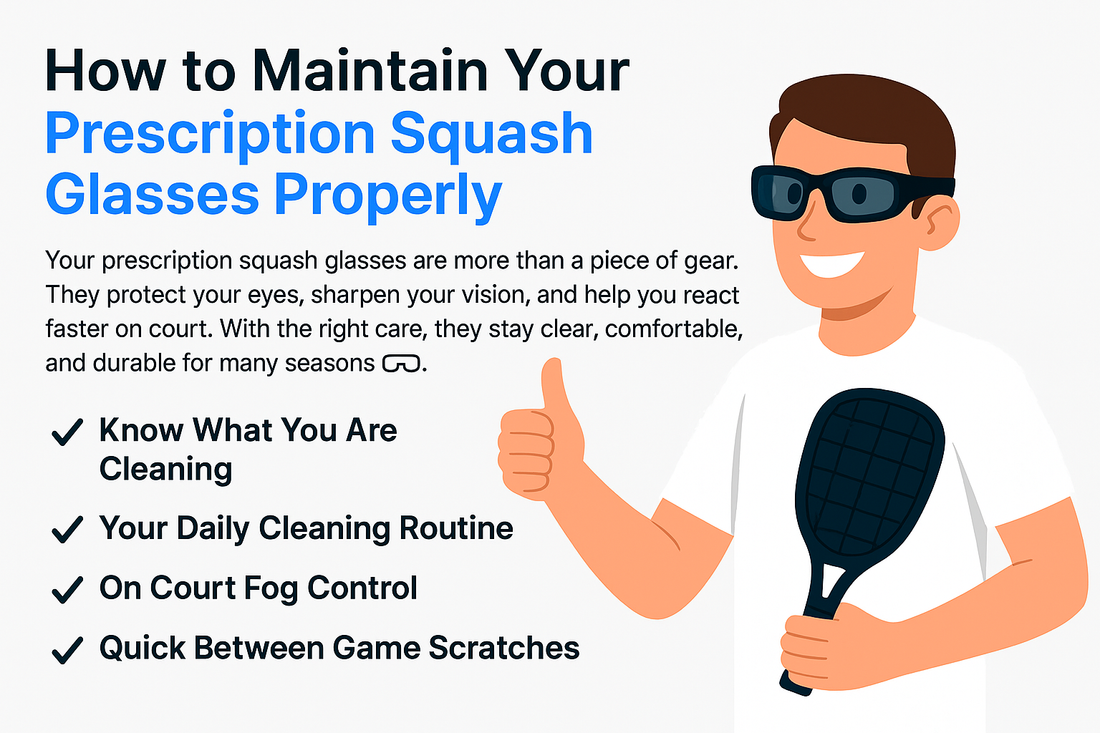
How to Maintain Your Prescription Squash Glasses Properly
Your prescription squash glasses are more than a piece of gear. They protect your eyes, sharpen your vision, and help you react faster on court. With the right care, they stay clear, comfortable, and durable for many seasons 🥽.
Know What You Are Cleaning
Most prescription squash lenses are polycarbonate with scratch resistant and sometimes anti-fog or hydrophobic coatings. Frames are often TR90 or impact resistant polycarbonate with a strap and vented design. These materials are tough, but they are sensitive to heat, harsh chemicals, and abrasive cloths. Treating them correctly preserves clarity and safety.
Your Daily Cleaning Routine
Start by rinsing lenses under a gentle stream of lukewarm water to float away grit. Add one small drop of mild, lotion-free dish soap and use clean fingertips to lightly wash both sides of the lenses and the frame. Rinse thoroughly, then shake off water and blot dry with a clean microfiber cloth. Avoid paper towels, shirt hems, and tissues that can scratch.
Skip household glass cleaners, acetone, alcohol, or vinegar. These can damage coatings. If you use an anti-fog solution, ensure it is labeled as lens and coating safe. Apply sparingly and let it set according to the instructions 💧.
On Court Fog Control
Fog forms when warm, moist air meets a cooler lens. Begin each match with clean, dry lenses. Use an anti-fog cloth or approved drop before play, and let it dry fully. Keep the strap snug but not overly tight so warm air can vent out. A moisture-wicking headband helps reduce sweat buildup. Avoid breathing directly into the lenses when you towel off between rallies.
Storage That Prevents Scratches
Always store your glasses in a hard, protective case when you are not wearing them. Do not toss them into a gear bag where they can rub against keys, balls, or grit. Place lenses facing up when you set them down. Keep them away from high heat, including car dashboards or radiators, since heat can warp frames and degrade coatings 🧼.
Fit Checks Keep Vision Sharp
Before each session, check that the nose pads sit comfortably and the frame aligns with your eyes. Inspect hinges and screws, and make sure the strap has enough elasticity to hold the frame stable without pinching. If the frame shifts on impact, adjust the strap or consider alternative nose pads for a better bridge fit. Minor adjustments can be done with guidance from an optical professional, and warm water can sometimes help ease small tweaks.
Handle Sweat and Salt Buildup
After play, rinse away sweat and salt, especially around nose pads, strap anchors, and vent channels. Salt crystals can abrade coatings and stiffen pads over time. A soft toothbrush reserved for eyewear helps gently clean crevices. Rinse thoroughly and let everything air dry before placing the glasses back in the case.
Quick Between Game Refresh
For a fast reset, use a lens-safe spray or pre-moistened lens wipe and a clean microfiber cloth. Dab, do not rub, to lift sweat and dust. Reapply anti-fog if needed and allow full drying before you step back on court. Keep a spare microfiber in a sealed pouch so you always have a clean cloth on hand.
Deep Clean, Done Right
Once a week, give your glasses a more thorough clean. Remove the strap if possible. Soak the frame and nose pads in lukewarm, lightly soapy water for five to ten minutes, then gently brush buildup from seams and vents. Rinse well and blot dry. Do not use abrasives or paste polishes. Replace worn nose pads or a slack strap to restore secure fit and comfort.
Know When to Replace
Small surface marks can be manageable, but deep scratches, cloudy coatings, or hairline cracks reduce optical clarity and can scatter light. If you notice persistent haze, rainbow patterns, or pressure marks that will not clean off, it may be time to replace the lenses or the full pair. Clear vision is critical for tracking the ball and reacting safely 🏃♂️.
Pro Tips to Extend Lifespan
- Carry a hard case, a spare microfiber cloth, and approved anti-fog wipes.
- Rinse first, then clean. Removing grit before wiping prevents micro-scratches.
- Let coatings cure fully after cleaning or anti-fog application before play.
- Keep a backup strap and nose pads in your bag for quick fixes mid-match.
Final Word
Clean correctly, store carefully, and keep the fit dialed in. With a few simple habits, your prescription squash glasses will stay clear, comfortable, and ready for every rally.
FAQs
How often should I clean my prescription squash glasses?
Rinse after every session and do a full clean daily if you play frequently. A weekly deep clean helps remove sweat and salt from crevices.
What cleaner is safe for my lenses?
Use lukewarm water, a drop of mild dish soap, and a clean microfiber cloth. Avoid ammonia, alcohol, vinegar, and abrasive products.
Can I use anti-fog on coated lenses?
Yes, if it is labeled coating safe. Apply lightly, let it dry completely, and reapply as directed.
Do tight straps cause fogging?
They can by trapping warm air. Keep the strap snug for stability but allow some ventilation around the frame.
Why are my lenses still cloudy after cleaning?
Residue or coating damage may be the cause. Rinse thoroughly, switch to a fresh microfiber, and inspect for scratches or worn coatings.



